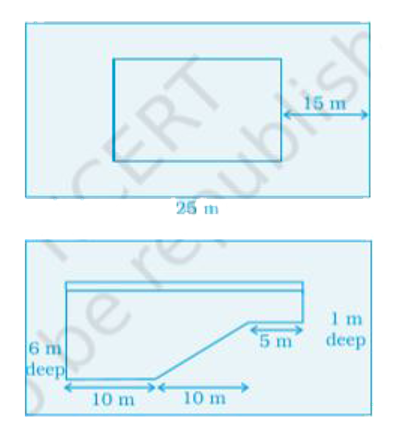The curved surface area of a cylinder is reduced by ____________ per cent if the height is half of the original height.
To solve the problem of how much the curved surface area of a cylinder is reduced when the height is halved, we can follow these steps:
1. Understand the formula for the curved surface area (CSA) of a cylinder:
The formula for the curved surface area of a cylinder is given by:
CSA=2πrh
where r is the radius and h is the height of the cylinder.
Hint: Remember the formula for the curved surface area of a cylinder.
2. Identify the new height:
If the height is reduced to half of the original height, we can express the new height as:
h′=h2
Hint: Think about how halving the height affects the dimensions of the cylinder.
3. Calculate the new curved surface area (CSA'):
Substitute h′ into the CSA formula:
CSA′=2πr(h2)
Simplifying this gives:
CSA′=2πr⋅h2=πrh
Hint: Simplify the expression carefully to see how the new CSA relates to the original.
4. Determine the reduction in curved surface area:
The reduction in curved surface area can be calculated as:
Reduction=CSA−CSA′=2πrh−πrh=πrh
Hint: Subtract the new CSA from the original CSA to find the reduction.
5. Calculate the percentage reduction:
The percentage reduction is given by:
Percentage Reduction=(ReductionCSA×100)=(πrh2πrh×100)
Simplifying this gives:
Percentage Reduction=(12×100)=50%
Hint: Remember to multiply by 100 to convert the fraction into a percentage.
Final Answer:
The curved surface area of the cylinder is reduced by 50% when the height is halved.
The formula for the curved surface area of a cylinder is given by:
CSA=2πrh
where r is the radius and h is the height of the cylinder.
If the height is reduced to half of the original height, we can express the new height as:
h′=h2
Substitute h′ into the CSA formula:
CSA′=2πr(h2)
Simplifying this gives:
CSA′=2πr⋅h2=πrh
The reduction in curved surface area can be calculated as:
Reduction=CSA−CSA′=2πrh−πrh=πrh
The percentage reduction is given by:
Percentage Reduction=(ReductionCSA×100)=(πrh2πrh×100)
Simplifying this gives:
Percentage Reduction=(12×100)=50%
The curved surface area of the cylinder is reduced by 50% when the height is halved.
Topper's Solved these Questions
- MENSURATIONBook:NCERT EXEMPLARChapter:MENSURATIONExercise:APPLICATIONS, GAMES AND PUZZLES
Explore 13 Videos
- MENSURATIONBook:NCERT EXEMPLARChapter:MENSURATIONExercise:THINK AND DISCUSS
Explore 2 Videos
- MENSURATIONBook:NCERT EXEMPLARChapter:MENSURATIONExercise:THINK AND DISCUSS
Explore 2 Videos
- LINEAR EQUATIONS IN ONE VARIABLEBook:NCERT EXEMPLARChapter:LINEAR EQUATIONS IN ONE VARIABLEExercise:THINK AND DISCUSS
Explore 3 Videos
- PLAYING WITH NUMBERS Book:NCERT EXEMPLARChapter:PLAYING WITH NUMBERS Exercise:Think and Discuss
Explore 1 Video
Similar Questions
Rashid has decided to build a swimming pool as shown in the figure on an empty plot 25 metres long and 15 metres wide. He is discussing with his son Majid about his plan to build the pool, put tiles on the bottom of the pool and other requirements of the pool. Can you help Majid to answer the following questions which his father has asked in the discussion?

What is the surface area of the pool?
View SolutionA cylindrical pillar is 50 cm in diameter and 3.5 m in height. Find the cost of painting the curved surface of the piller at the rate of Rs10 per sq. m.
View SolutionA cylindrical pillar is 50 cm in diameter and 3.5 m in height. Find the cost of painting the curved surface of the piller at the rate of Rs10 per sq. m.
View SolutionSolve for x: 2x−53+x−32=16+2x
View SolutionWhat would be the value of y, if 277y is divisible by 11?
View Solutionएक बेलन में, त्रिज्या दोगुनी है तथा ऊँचाई आधी है तो वक्र पृष्ठीय क्षेत्रफल होगा :-
View SolutionThe curved surface area of the cylinder is 900 cm2 If the circumference of the base and its height are equal then height of the cylinder is . . . . .
View SolutionThe lateral surface area of a cylinder is equal to the curved surface area of a cone. If their base be the same, find the ratio of the height of the cylinder to slant height of the cone.
View Solutionयदि एक बेलन की त्रिज्या दो गुनी कर दी जाए और ऊँचाई आधी कर दी जाए तो उसका वक्र पृष्ठीय क्षेत्रफल :
View SolutionThe lateral surface area of a cylinder is equal to the curved surface area of a cone. If their base be the same, find the ratio of the height of the cylinder to slant height of the cone.
View SolutionThe height of the cylinder is 7cm and the radius is 2cm, then the curved surface area of the cylinder will be -
View SolutionThe lateral surface area of a cylinder is equal to the curved surface area of a cone. If their base be the same, find the ratio of the height of the cylinder to slant height of the cone.
View SolutionThe lateral surface area of a cylinder is equal to the curved surface area of cone . If their bases are the same, find the ratio of the height of the cylinder to the slant height of the cone.
View SolutionThe lateral surface area of a cylinder is equal to the curved surface area of cone . If their bases are the same, find the ratio of the height of the cylinder to the slant height of the cone.
View SolutionThe lateral surface area of a cylinder is equal to the curved surface area of cone . If their bases are the same, find the ratio of the height of the cylinder to the slant height of the cone.
View Solution